Indiana‘s diverse landscape offers a delightful canvas for gardening enthusiasts. However, when it comes to ensuring a vibrant bloom, it’s crucial to plant flowers suited to the state’s specific climate. With Indiana only falling within hardiness zones 5 and 6, certain flowers will naturally thrive more than others. This article will introduce you to 15 of the best flowers to plant in Indiana for a truly dazzling display. Whether you’re a seasoned gardener or just getting your hands dirty for the first time, these selections, mindful of the local hardiness zones, will set you on the path to a flourishing garden.
1. Oregon Sunshine (Eriophyllum lanatum)
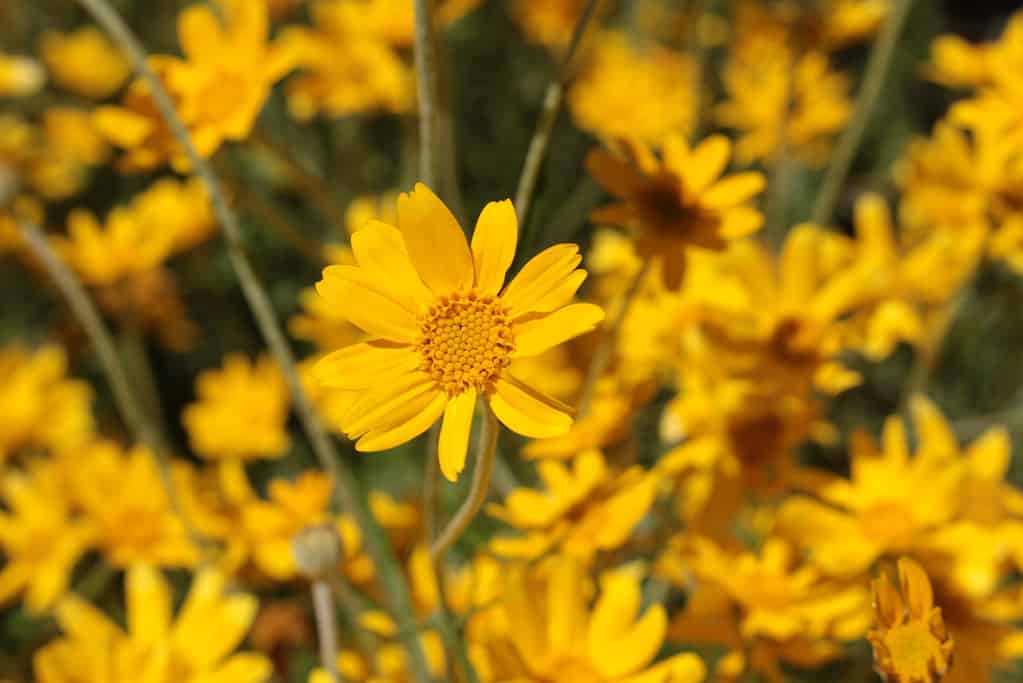
Plant Oregon sunshine for gorgeous yellow flowers in Indiana!
©RukiMedia/ via Getty Images
Topping the list of the ideal flowers to plant in Indiana is the Oregon sunshine. This small perennial boasts a delicate mat of silvery foliage, each leaf measuring between 1 to 3 inches, sporting slender lobes. The entire plant, from stems to leaves, is adorned with white, fuzzy hairs. When summer arrives, this flower bursts into life with radiant golden-yellow blooms resembling mini sunflowers, becoming a magnet for bees and butterflies.
Position the Oregon sunshine in borders, alongside walkways, or even in rock gardens and slopes. It’s a champion in handling dry, sandy, or rocky terrains.
This flower flourishes best in sunny to partially shaded spots, thriving in dry to moderately moist, well-draining soil. Once settled, it requires minimal watering. For best results, plant Oregon sunshine during the fall months.
2. Basket Of Gold (Aurinia saxatilis)
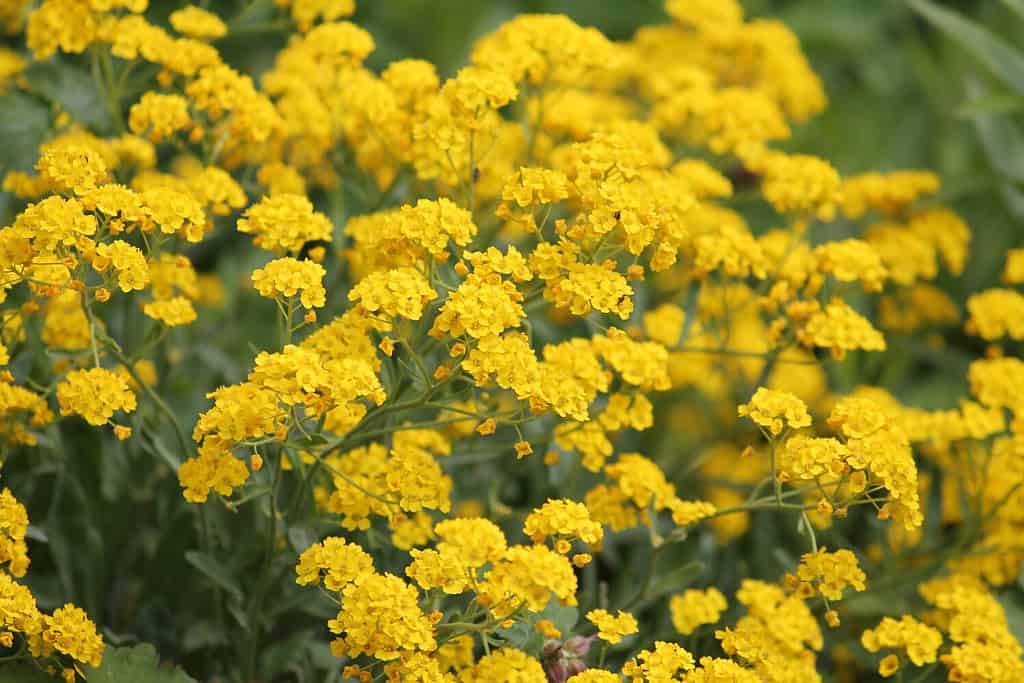
Basket of gold is an award-winning perennial with golden-yellow blooms.
©Kazakov Maksim/Shutterstock.com
A delightful gem in the garden, the basket of gold is a compact, evergreen perennial that captivates with its profusion of radiant, golden-yellow blooms that grace the garden for a month or more in spring. This brilliance pairs perfectly with its subtle gray-green leaves.
It’s especially eye-catching in rock gardens or when draped over the borders of raised beds. Beyond its bloom time, this versatile mat-like plant transitions to a lovely ground cover.
Honored with the Award of Garden Merit by the Royal Horticultural Society, it thrives best in sunlit spaces and prefers dry to moderately moist, sandy, well-draining soil. In regions with intense afternoon heat, a bit of shade is beneficial. Consider planting the basket of gold in the ground either in the fall or at the start of spring.
3. False Indigo (Baptisia australis)
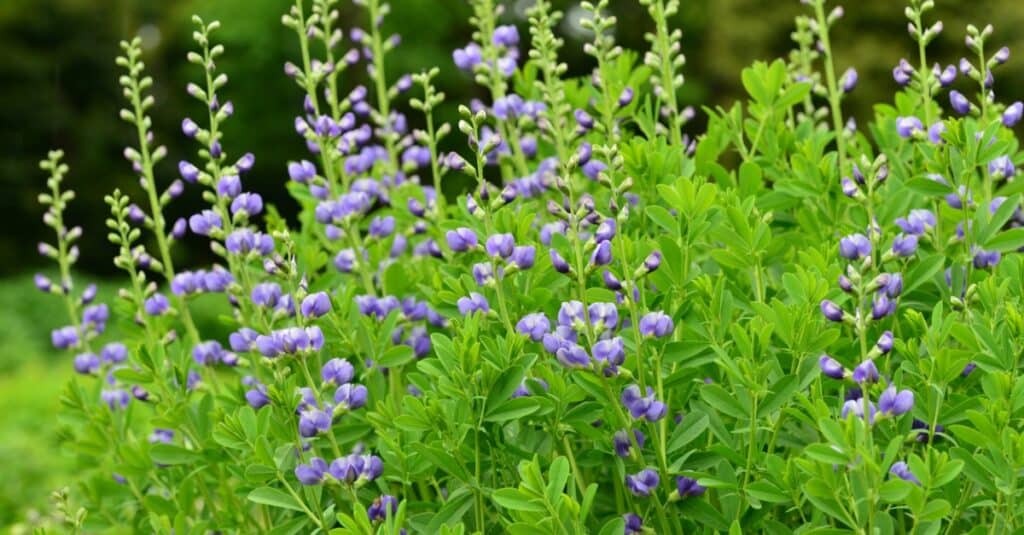
False indigo is a flower you should plant in Indiana.
©iStock.com/magicflute002
Resilient and captivating, false indigo is a perennial that offers a visual treat throughout its long growth period. During spring, this native of North American grasslands showcases spikes of blue flowers reminiscent of lupines. These blooms last around three weeks, drawing butterflies, bees, and hummingbirds!
Post-bloom, its striking blue-green, three-parted leaves remain, providing an elegant backdrop for neighboring garden plants.
Esteemed with the Royal Horticultural Society’s Award of Garden Merit and crowned ‘Perennial Plant of the Year’ in 2010, it seeks basic care: full sunlight and moderately dry to average, well-draining soil. To witness false indigo blossoming from late spring to the start of summer, get them in the soil by the beginning of spring.
4. China Aster (Callistephus chinensis)
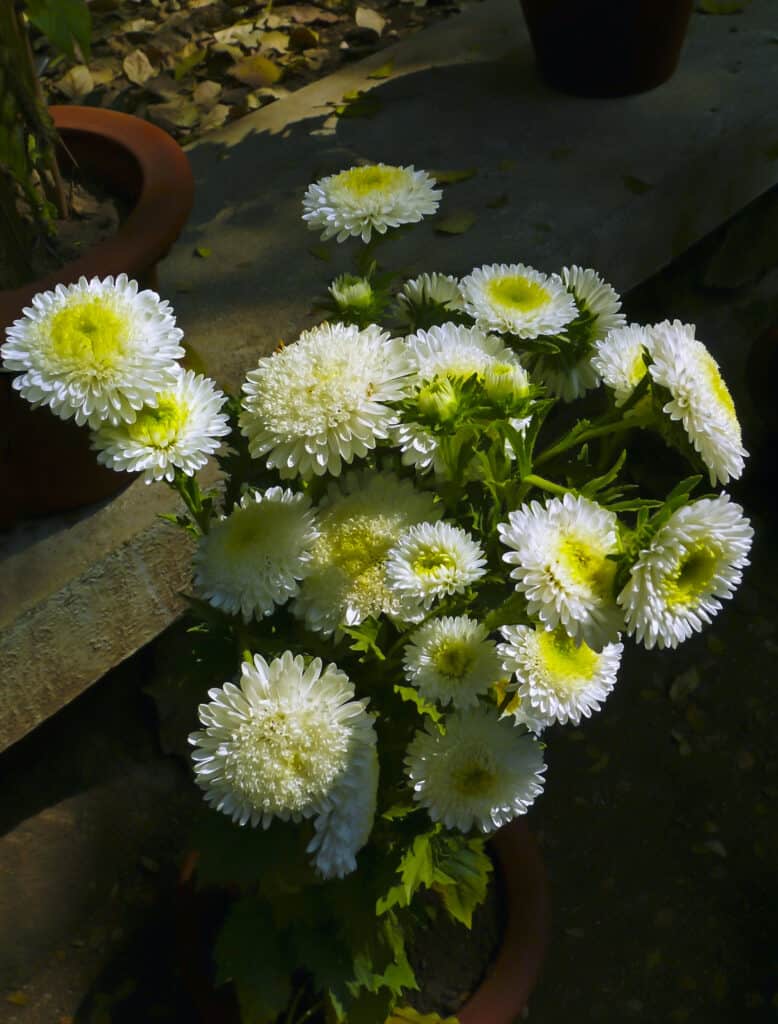
The China aster is a gorgeous flower that thrives in Indiana and comes in many colors.
©iStock.com/yogesh_more
Native to China, the China aster stands out as a stunning annual, renowned for its radiant hues and abundant blooms that grace gardens from early summer to fall. Whether they’re nestled in garden beds or brightening up patios in pots, these stunning flowers also make for lovely indoor arrangements.
With blossoms spanning 3 to 5 inches, these flowers range from simple daisy-like designs with a sun-kissed center to intricate, full-bodied pompoms. Their color spectrum is vast, featuring shades from pristine white to deep violet, encompassing pinks, reds, blues, and yellows.
China asters thrive without fuss. These annuals crave either full sunlight or partial shade and flourish best in nutrient-rich, consistently moist, well-draining soil. For China aster seeds, it’s ideal to start them indoors, roughly 6 to 8 weeks ahead of the final frost of spring.
5. False Saffron (Carthamus tinctorius)
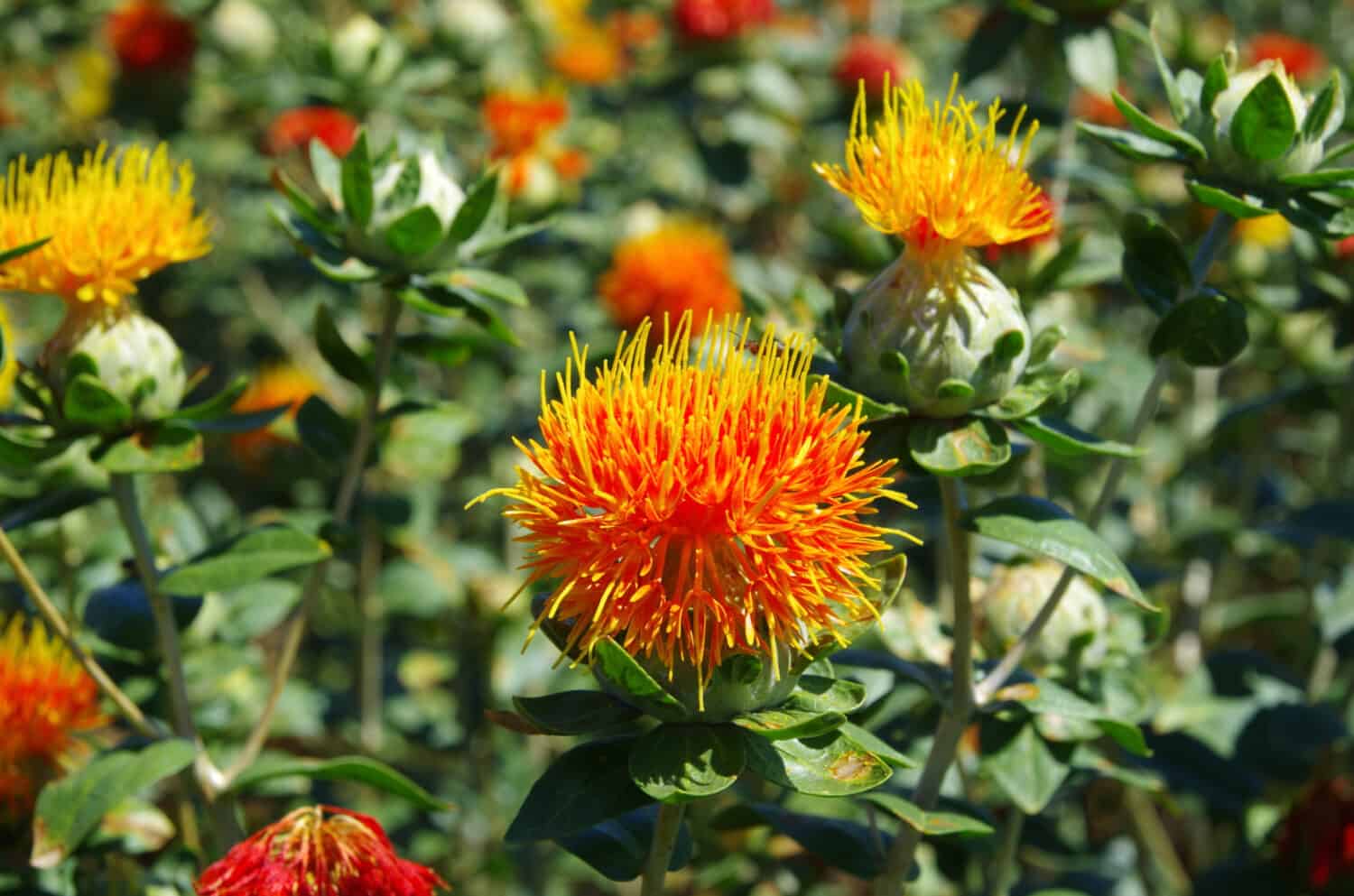
Boasting bright yellow or orange, fluffy flowers, false saffron lights up Indiana gardens.
©Ihor Shalev/Shutterstock.com
False saffron grows tall, showcasing an abundance of bright yellow or orange, fluffy flowers that resemble small thistles, each about an inch wide. These flowers, set against spiky green backgrounds, light up gardens from mid-spring to early fall, giving life to 15 to 50 seeds (per flower), rich in vegetable oil.
Each stem carries between 1 to 5 of these blooms, which emerge from stems with thorny leaves. Historically, these flowers have been cultivated not only for the rich dye they produce but also for their seeds laden with oil.
This plant loves the sun and isn’t picky about the soil type as long as it’s well-draining. Its robust root system offers impressive resistance to both heat and drought. If you’re looking to grow false saffron, simply sow its seeds anytime from early to late spring.
6. Chocolate Daisy (Berlandiera lyrata)
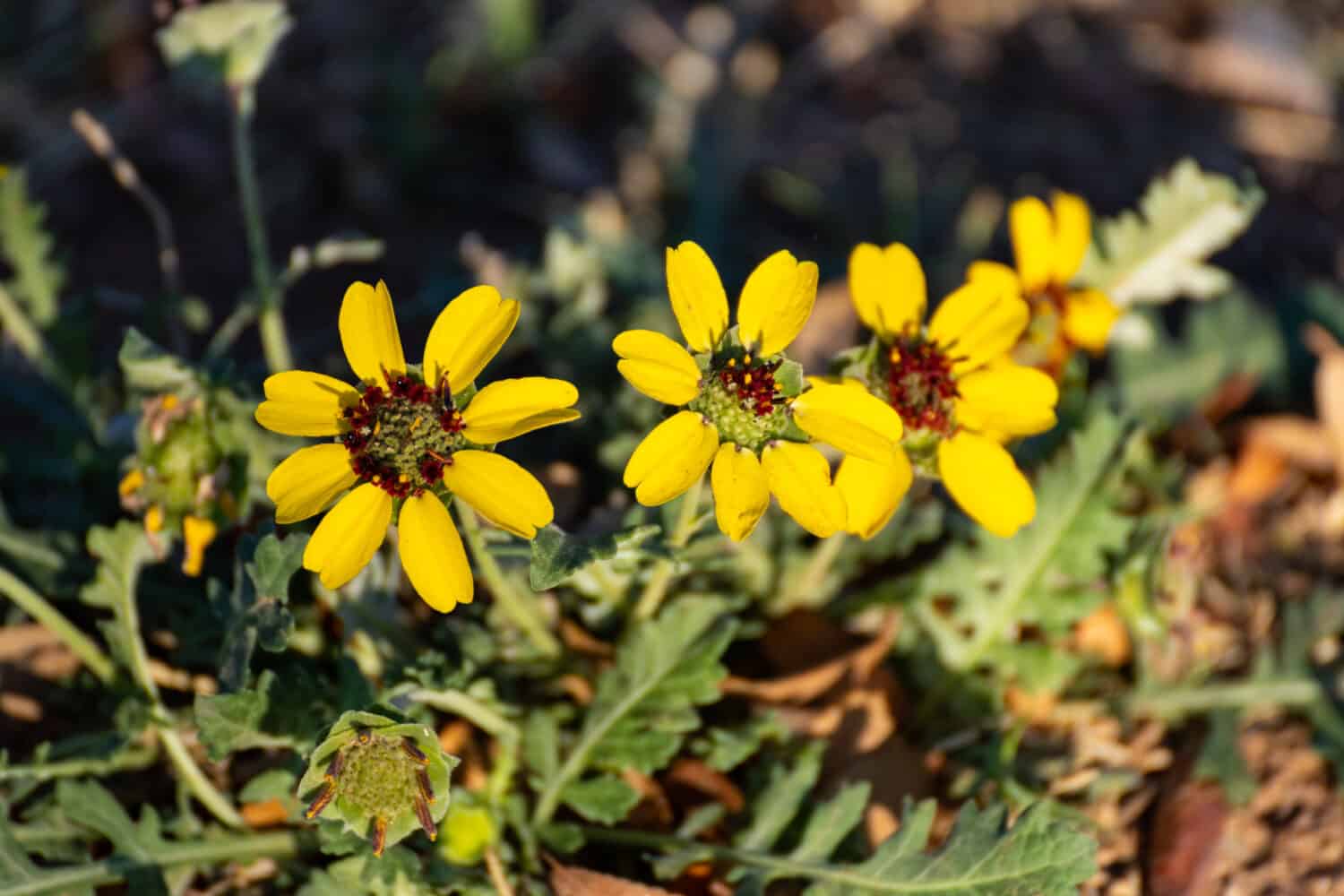
Plant chocolate daisy flowers for a delicious chocolate aroma in your Indiana garden.
©G B Hart/Shutterstock.com
With a delightful aroma that smells just like chocolate, the chocolate daisy is an eye-catching perennial that flaunts daisy-like blooms. These 2-inch-wide flowers feature sunny yellow petals encircling a deep maroon center, complemented by greenish protective bracts.
These fragrant flowers bloom consistently from late spring through to fall, and even year-round in milder climates, bringing a splash of color and a distinctive cocoa scent to any garden space.
This plant revels in sunshine and thrives in moderate, well-draining soils, having a preference for sandy textures. While it loves the sun, it can also manage a bit of shade. If you’re thinking of adding chocolate daisy to your garden, simply sow its seeds during any frost-free period of the growing season.
7. Greek Yarrow (Achillea ageratifolia)
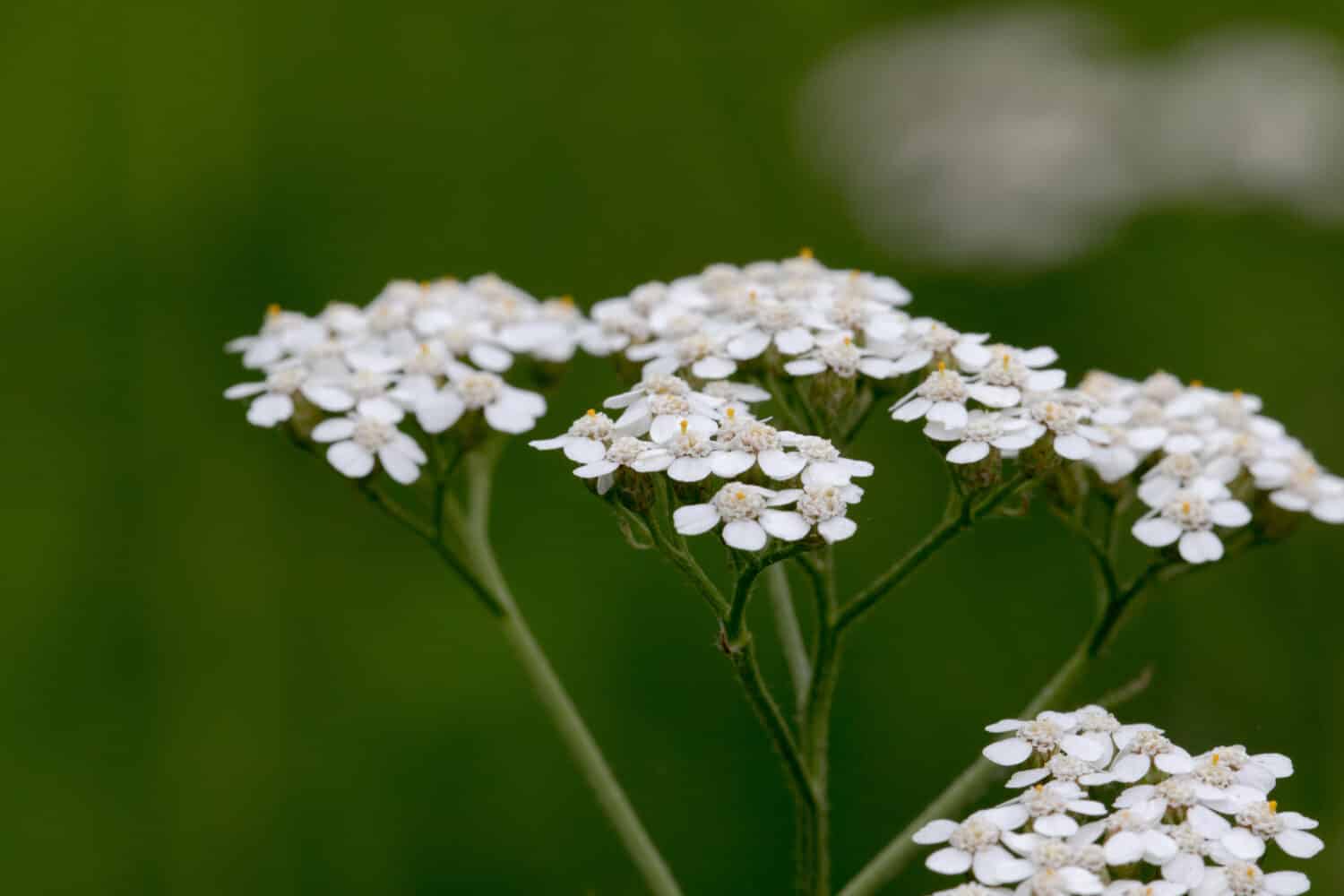
Greek yarrow boasts striking white flowers that emerge in clusters.
©RMVera/Shutterstock.com
Prized for its captivating appearance, the Greek yarrow is a semi-evergreen perennial that sports a dense clump of fragrant, slender, silver-green leaves, each about 1.5 inches in length. In places with milder winters, this plant retains its green color throughout the season.
From spring to early summer, striking white flowers, roughly an inch wide, emerge in delicate clusters, standing out against the foliage.
This plant is versatile — it’s perfect as a ground cover for smaller areas, fits beautifully in rock gardens, and shines in containers. It’s also a treat when planted near walkways, letting passersby admire it up close.
Having been recognized with the esteemed Award of Garden Merit from the Royal Horticultural Society, Greek yarrow thrives in sunlight, preferring slightly dry, well-aerated sandy soils. If you’re planning on adding it to your garden, consider sowing its seeds during the fall or as spring starts.
8. Sunset Hyssop (Agastache rupestris)

Boasting salmon-orange flowers, sunset hyssop is a great flower to plant in Indiana gardens.
©Alex Manders/Shutterstock.com
The sunset hyssop is another perennial with striking spikes of tubular, salmon-orange blooms complemented by purple tinges, which emerge from early to late summer. These vivid flowers rise over the plant’s slender, silvery-green leaves, offering a visual treat.
Known for enhancing gardens with its color and distinct spiky appearance, this flower is a gem in Indiana landscapes. Moreover, it becomes a bustling hub of activity, drawing hummingbirds, butterflies, and other pollinators in droves.
For those looking to cultivate sunset hyssop, choose a sunny spot. It thrives in moderate, well-draining soils that lean towards the dry side. It’s crucial to ensure good drainage as it isn’t fond of overly moist conditions. If you’re starting with seeds, you can plant them directly outdoors after the last spring frost.
9. Floss Flower (Ageratum houstonianum)
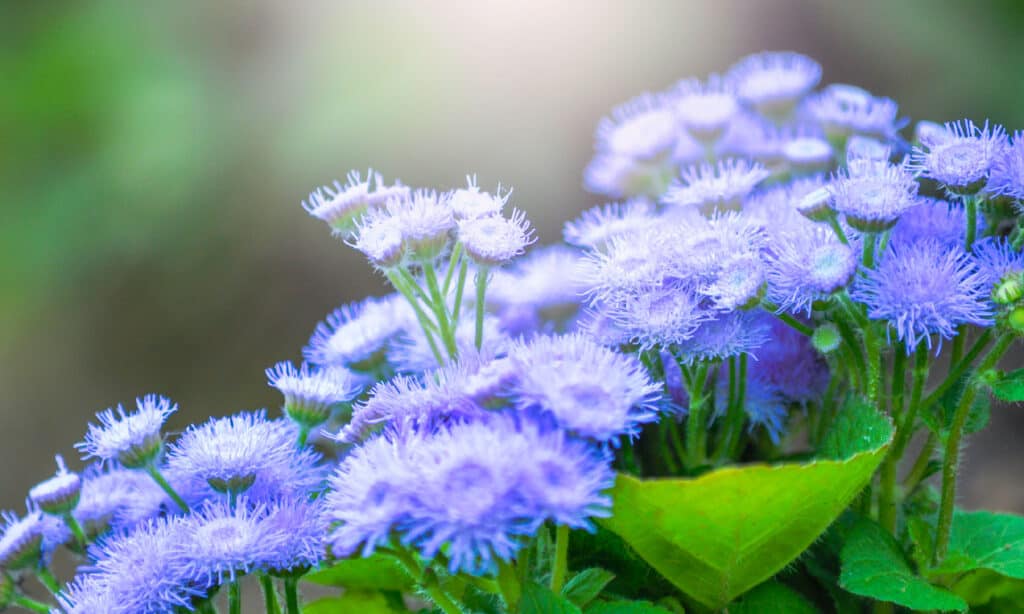
Coming in various colors, the floss flower has puffy clusters.
©undefined undefined/Shutterstock.com
The floss flower, known for its soft, puffy clusters, is one of the rare annuals comfortable in partial shade. It graces gardens with continuous blossoms from mid-summer to fall, forming neat mounds that can range between 6 and 24 inches in height. This flower complements both other annuals and perennials beautifully.
Its palette includes shades of blue, lavender, purple, pink, white, red, and even dual colors, offering a delightful contrast in garden beds.
For optimal results, place it in sunlit areas with nutrient-rich soil that drains well. Keeping the soil consistently moist through the growing season is key. For planting, wait until the chill of spring frost has subsided and the soil feels warm.
10. Ornamental Onion (Allium atropurpureum)

The ornamental onion is a perennial with purple blooms.
©Zigmunds Dizgalvis/Shutterstock.com
Ideal for the Indiana weather, the ornamental onion is a resilient perennial bulb that showcases starry, rich purple blooms arranged in a semi-spherical cluster about 2 inches across. These flowers boast a deep wine-red hue with striking deep blue centers, offering a captivating color play.
These flowers make their appearance from late spring to early summer, emerging from robust, straight stems with elongated green leaves beneath. Even after the bloom, leaving the seed heads in place can enhance your garden’s appeal for several more months.
This plant thrives in nutrient-rich, somewhat sandy, and well-draining soil under full sunlight. When it comes to planting ornamental onions, the fall season is best, burying them around 4 to 5 inches deep to shield them from frost.
11. Pearly Everlasting (Anaphalis margaritacea)

A perennial perfect for Indiana gardens, pearly everlasting boasts golden yellow flowers with white bracts.
©Olga Ganovicheva/Shutterstock.com
The renowned pearly everlasting is a prolific perennial displaying clusters of enduring, button-like blooms that are a top choice for dried flower displays.
These compact flowers showcase golden-yellow centers encased in delicate white, paper-like bracts that mimic petals. Rising on upright stems, they’re paired with lance-shaped leaves — a muted green on the surface but a soft, woolly white underneath. The curled edges of these leaves present a shimmering, silver-lined appearance.
Honored with recognition from the Royal Horticultural Society, this plant flourishes in spots with full sun to partial shade, thriving in moderately moist and well-draining soils. Plant time is flexible, from spring to fall.
12. Pacific Anemone (Anemone multifida)
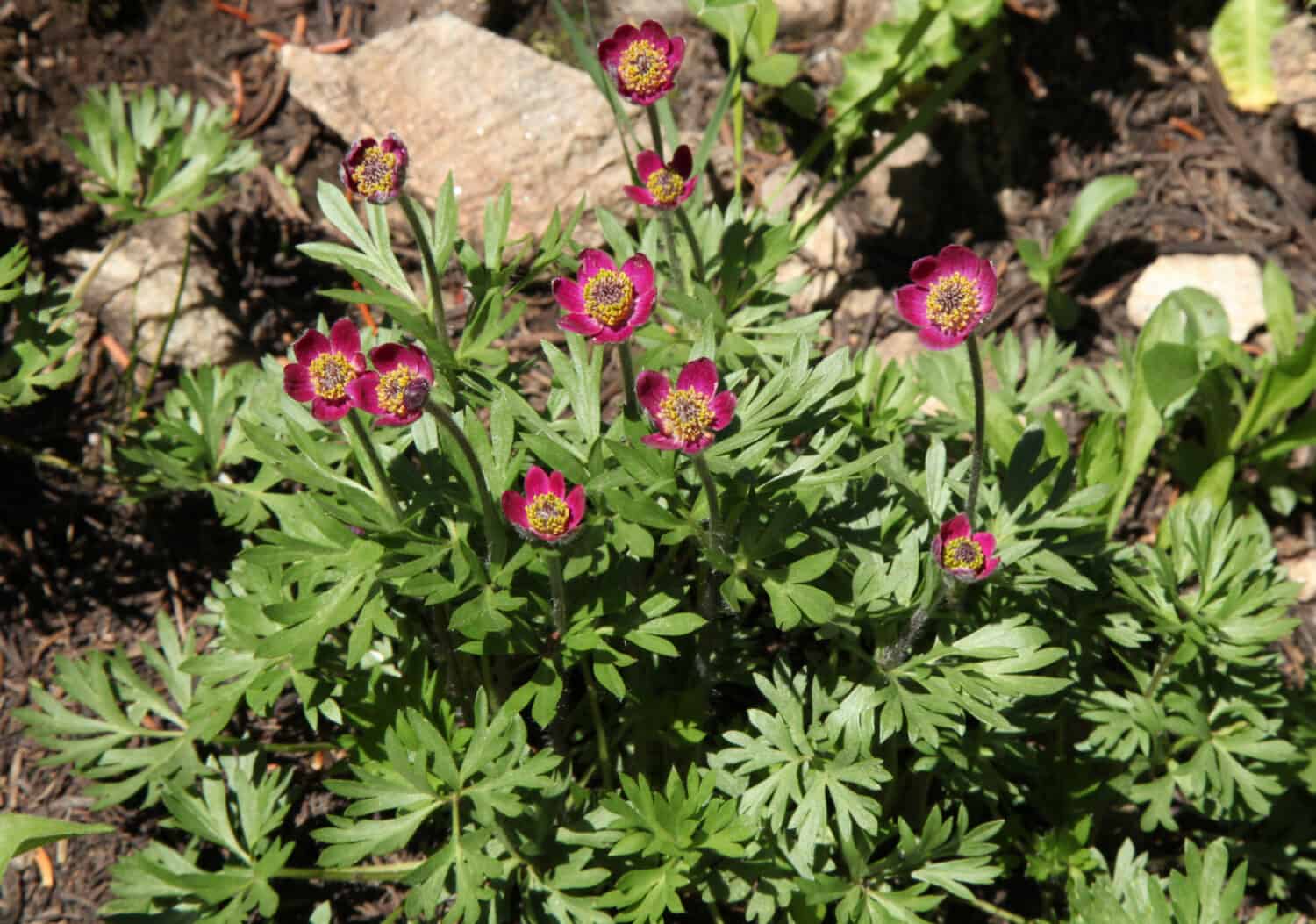
A perennial, the Pacific anemone thrives in part shade.
©Nikki Yancey/Shutterstock.com
The Pacific anemone is a well-known perennial that sprouts slender stems covered in feathery, downy leaves. From late spring through summer, unique flowers bloom, showcasing an outer color ranging from green to purple, while inside, they glow with a soft, yellowish-white tint.
Following this floral display, pink-hued, feathery seedheads emerge, which hummingbirds often collect for nest-making. The Pacific anemone thrives in partly shaded areas, making it a perfect addition to woodland settings or gardens that receive less direct sunlight.
This plant flourishes in moist, well-draining soils with a hint of lime. To propagate, seeds can be sown in the cooler months of fall or early spring. Mature plants can be split and replanted in springtime.
13. Mountain Everlasting (Antennaria dioica)
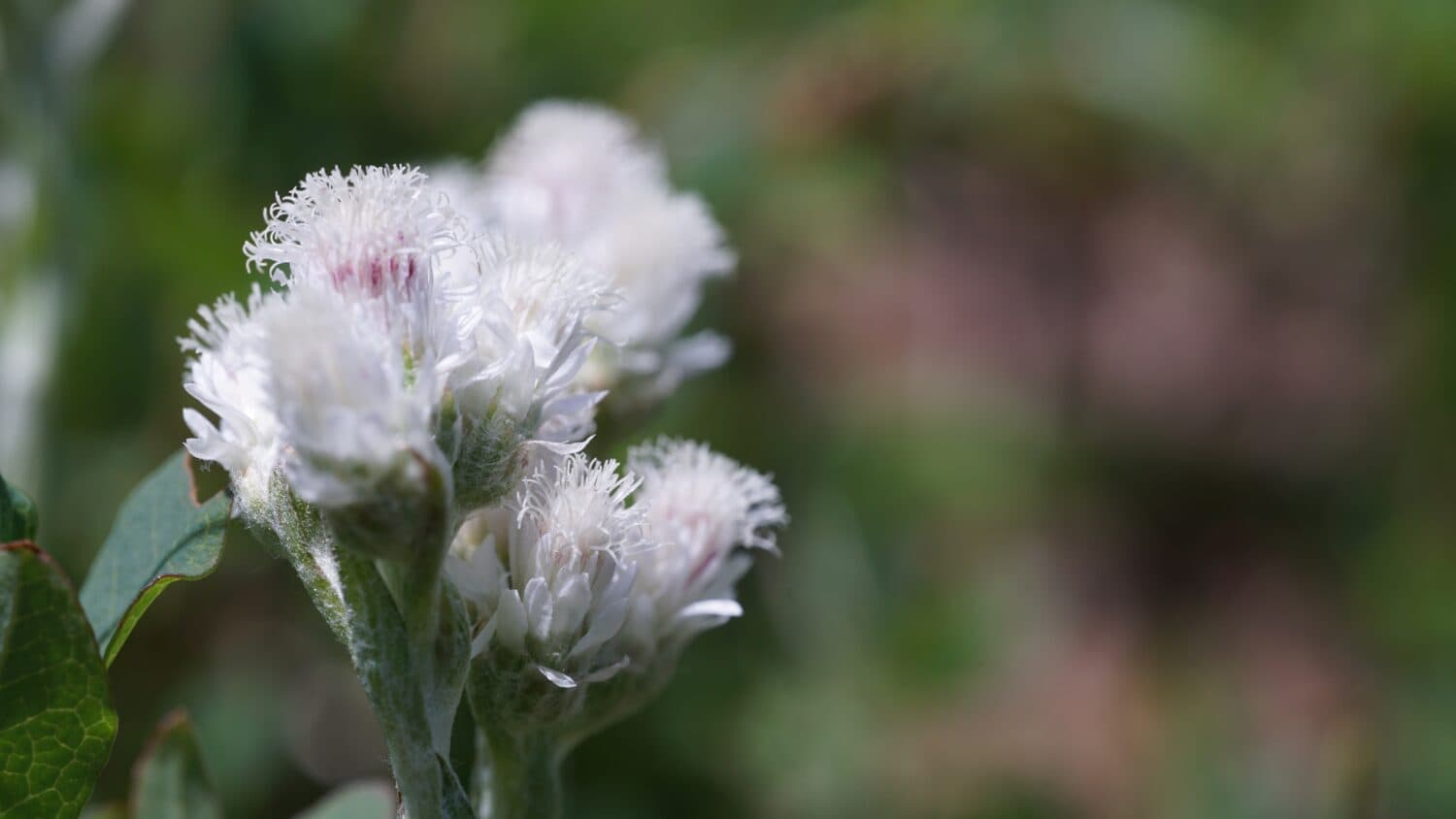
Another flower you should plant in Indiana is mountain everlasting.
©Luca love photo/Shutterstock.com
Mountain everlasting is a durable perennial that showcases a blanket of petite, silvery-blue leaves, giving a shimmering effect. Around late spring, this plant sprouts stems crowned with soft white or pink blossoms, evoking the image of a cat’s paw, hence its other common name: pussy toes.
These flowers are unique; they have separate male and female plants. One of their great features is that there’s no need to prune old flowers to maintain their appearance. With time, it expands gently, presenting a silvery canvas on the ground.
It thrives when bathed in sunlight and planted in moderately nourishing, well-draining sandy soils. If you’re looking to propagate, you can either split it or plant its seeds in the spring.
14. Alpine Columbine (Aquilegia alpina)
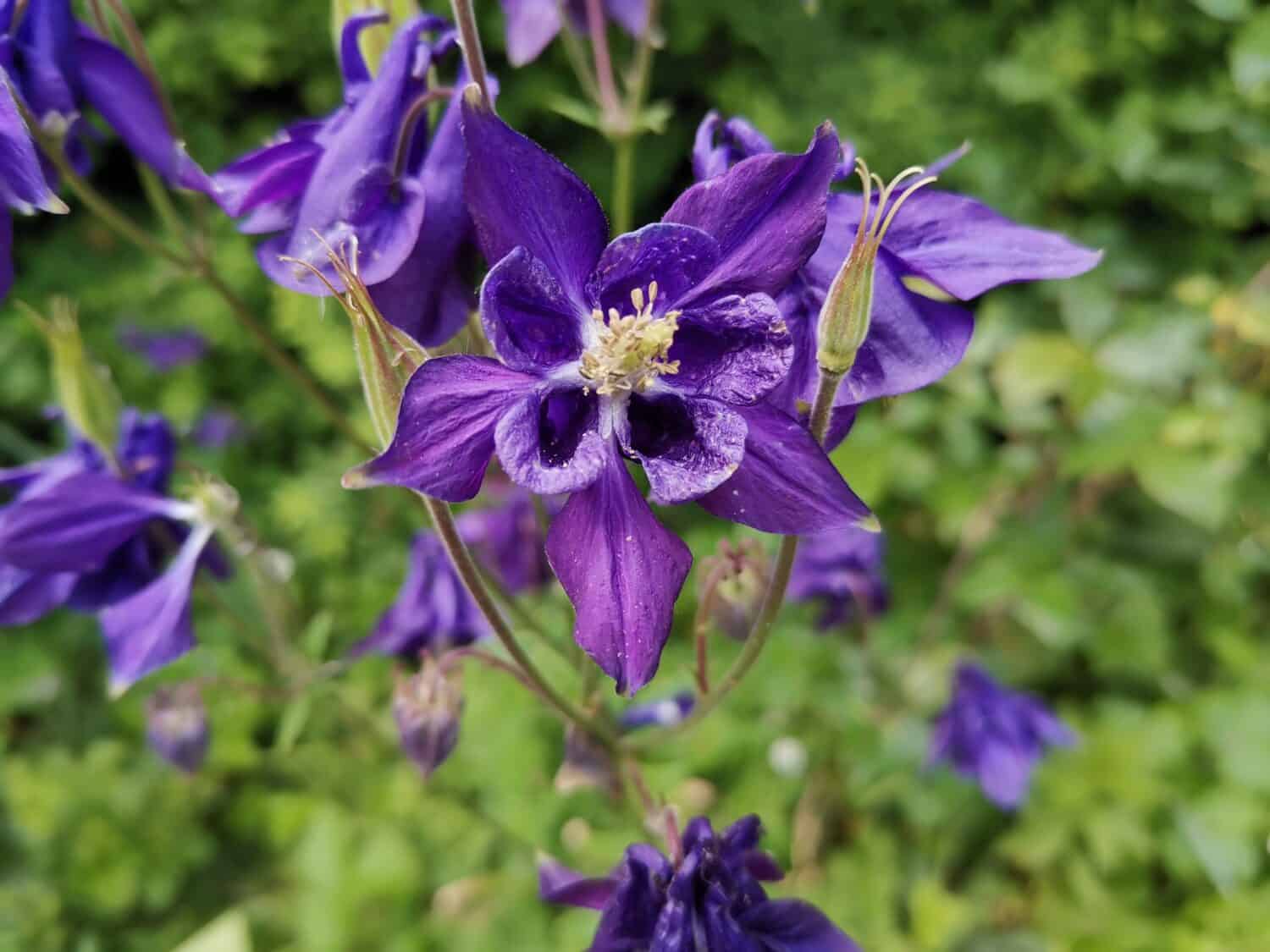
Alpine columbine boasts vivid blue flowers.
©NOOR RADYA BINTI MD RADZI/Shutterstock.com
Originating from the high grasslands and mountainous regions of Europe, alpine columbine is a small flower that flaunts vivid violet-blue blossoms. These hat-like flowers, measuring 2 to 3 inches across, dance on thin stems, beautifully contrasting with their delicate, bluish-green leaves. They predominantly bloom from late spring to early summer, with a potential second showing in the fall, adding a splash of color to shaded areas.
While this perennial might not have a long lifespan, it’s known to spread its seeds generously, naturally multiplying and creating expansive patches when it’s happy with its surroundings.
It flourishes when placed under a mix of sun and shade and prefers soil that’s moderately moist and well-draining. It’s essential to avoid poorly drained soils! Plant during the milder temperatures of spring after the danger of frost has passed.
15. Butterfly Weed (Asclepias tuberosa)
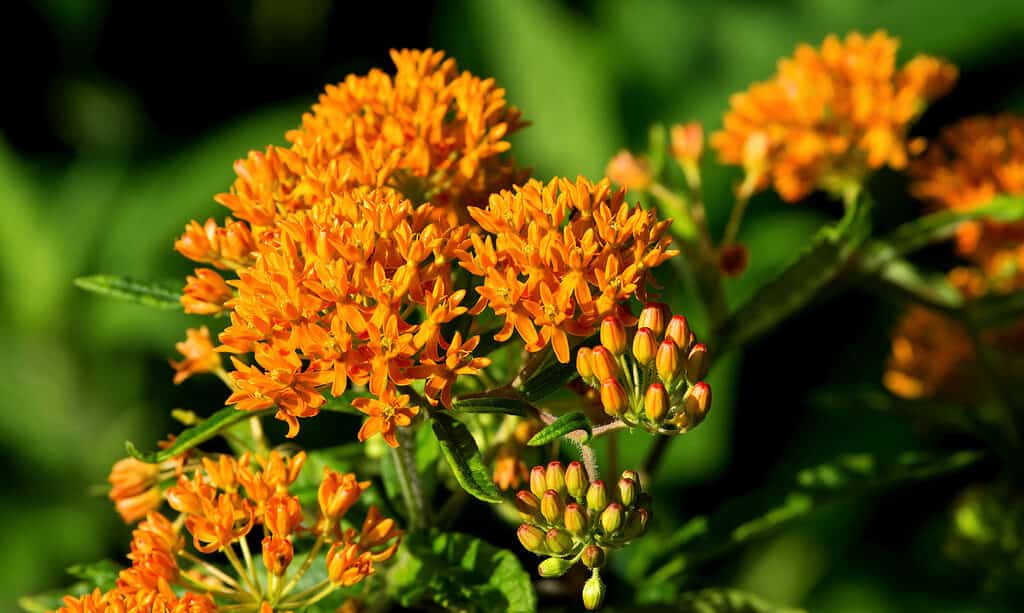
Butterfly weed boasts orange to yellow flowers that bloom all summer long.
©iStock.com/McKinneMike
Requiring minimal attention, resilient to drought, and often ignored by deer, butterfly weed is a robust perennial loved for its vibrant clusters of sunny orange to golden-yellow blooms that consistently grace gardens throughout the summer. These lively blossoms, spanning 2-5 inches, stand proudly on stems surrounded by rigid, lance-like leaves and give way to captivating seed pods come fall.
Its rich green leaves set a contrasting stage, enhancing the brightness of its starry flowers. Distinct from many other milkweeds, this native North American wildflower lacks the typical milky sap.
Best suited for sunny spots, this plant flourishes in soils that are moderately moist but well-draining. Typically, butterfly weed is planted once the soil feels warm in the late spring.
Summary of Best Flowers to Plant in Indiana
| Number | Flower | Blooming Season | Hardiness Zone |
|---|---|---|---|
| 1 | Oregon Sunshine | Late spring to early summer | 5-8 |
| 2 | Basket Of Gold | Late spring to early summer | 3-7 |
| 3 | False Indigo | Late spring to early summer | 3-9 |
| 4 | China Aster | Early summer to fall | 2-11 |
| 5 | False Saffron | Mid-spring to early fall | 2-11 |
| 6 | Chocolate Daisy | Late spring to fall | 4-10 |
| 7 | Greek Yarrow | Spring to early summer | 3-8 |
| 8 | Sunset Hyssop | Summer to early fall | 5-9 |
| 9 | Floss Flower | Mid-summer to fall | 2-11 |
| 10 | Ornamental Onion | Spring to summer | 4-7 |
| 11 | Pearly Everlasting | Mid-summer to fall | 3-8 |
| 12 | Pacific Anemone | Late spring to late summer | 3-9 |
| 13 | Mountain Everlasting | Late spring to summer | 3-8 |
| 14 | Alpine Columbine | Late spring to early summer | 4-8 |
| 15 | Butterfly Weed | Summer (8 weeks) | 3-9 |
Thank you for reading! Have some feedback for us? Contact the AZ Animals editorial team.







